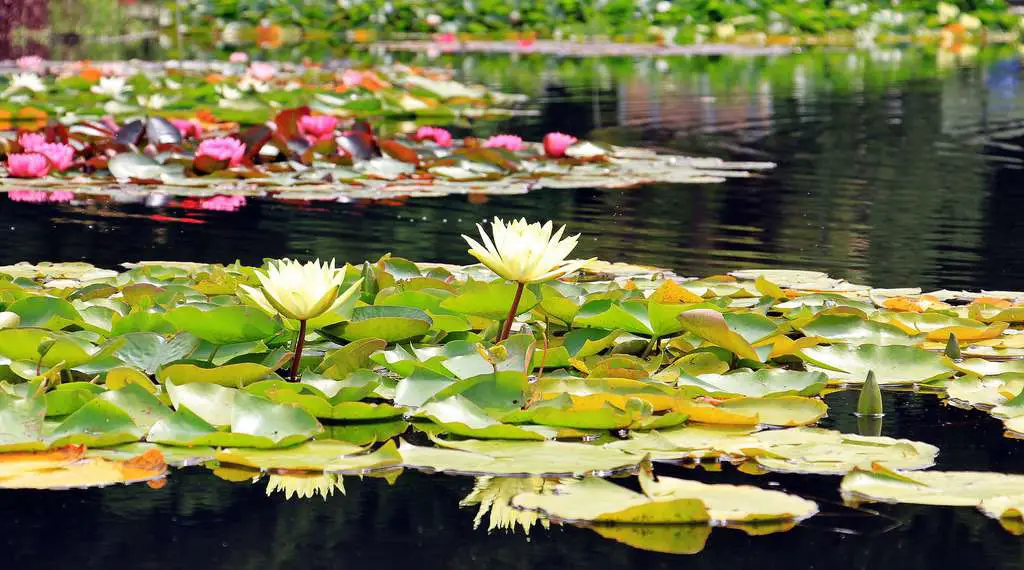No aquarium, pond, or water garden is complete without the presence of aquatic plants. However, picking the perfect water plants that fit your needs and preferences can be surprisingly tricky– especially for beginners.
There are many different aquatic plants (floating, submerged, emergent plants) to choose from, many of which have their own unique characteristics and habits. In short, there is no “one size fits all” plant species in selecting the best aquatic plants.
To help you get started, this article will cover just about everything you need to know about keeping water plants in your pond or water garden, including their different types, their functions, and how to best use them in your world of water.
What are Aquatic Plants?
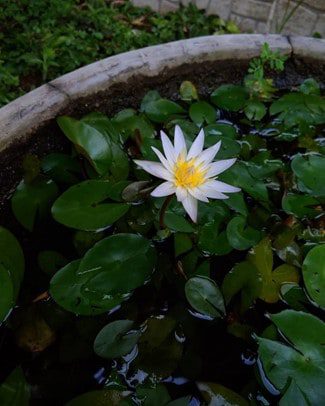
Photo from @stevenstph (IG)
Aquatic plants thrive in watery environments. Also known as hydrophytes or aquatic macrophytes, these plants vary widely in their ability to adapt to their surroundings. Some are entirely submerged, while others are partially submerged, and some float on the surface.
Most aquatic plants spread their fibrous roots through whatever debris and mud has accumulated at the bottom of their aquatic environment. Some of them can be free-floating on the surface, some are completely submerged and others just poke above the surface. They can be found in all types of aquatic environment and many are used to help us clean even our most polluted waters.
Popular examples of water plants are Anubias, African water fern plants, water purslane, and waterweed plants. Meanwhile, common aquatic flowers include lotus, mosaic flowers, water lilies, and water hawthorn plants.
In most cases, you will only have limited space in your water feature for aquatic plants, so it is very important to choose your plants wisely. Many can grow quite rapidly and will fill up their space quickly. You need to select each plant and its intended purpose carefully, whether to add vibrancy or color, add height, or control algae growth.
Choose a variety of aquatic plants for your water, to add texture and visual appeal, as well as to improve water quality. Most aquatic plants are quite hardy and require very little care from us.
General Characteristics of Aquatic Plants
Aquatic plants are excellently adapted to aquatic environments, including lakes, ponds, estuaries, marine lagoons, swamps, and river banks.
To adapt to their water habitat, these plants have common characteristics, which are listed below:
● Some aquatic plants have floating leaves on the water surface, whereas others emerge entirely above water. Some water plants are also submerged, meaning they grow entirely underwater. Some of these plants are free-floating and some have roots attached to the bottom soil.
● Plant cuticles limit water loss in most ordinary plants. Because aquatic plants live in water and aren’t threatened by water loss, most aquatic plants don’t need them. If they do, they have thin ones. They also have several stomata on either side of their leaves. As they don’t need to retain water, aquatic plants leave their stomata open most of the time.
● Because their stems are typically supported by water pressure, many aquatic plants have a less rigid structure. Their leaves generally appear flat on the surface because they must float. The air sacs in the leaves allow them to float.
● Their roots are typically small to allow water to flow into the leaves freely and are light and feathery because they don’t need to prop up or support the plants.
● Since they thrive in watery environments, their roots are specialized to take in oxygen. In the case of trees like swamp cypress, these water plants possess special roots (pneumatophores) to breathe. These roots stick out of the water surface to reach oxygen. Some aquatic plants, like duckweed, have an air-filled chamber under their leaves, allowing them to float.
● To adapt to swamps and waterlogged habitats, water plants can perform a biochemical process that helps prevent harmful chemicals from accumulating in low oxygen or anaerobic medium conditions.
Over the years, aquatic plants have adapted to cope with the many different water habitats that they grow in. Aquatic plants are the filters of our earths water and will continue to be long after we are gone.
Functions of Aquatic Plants
Apart from serving as an attractive centerpiece in water gardens or ponds, there are a many other functions of aquatic plants such as providing oxygen, food, and shelter to other organisms.
Let’s go into detail as to why water plants are so important:
Ecosystem Benefits
Aquatic plants provide many ecological benefits. For instance, they provide food and habitat for sea animals. Sea grasses are a food source for many commercial and recreational fishes.
This greenery also strengthens soil stability, preventing the erosion of shorelines in all varieties of water bodies. Many water plants are known to stabilize sediments, add oxygen to the surrounding water, and generate organic materials.
Water plants promote the diversity and function of aquatic systems (marine habitats and freshwater habitats). They produce oxygen and consume CO2 during the day, benefitting fishes and helping with filtration and pH stabilization. These plants also prevent unwanted algae growth by removing nitrates and phosphates from the water.
Underwater plants in coastal waters also foster a diversity of marine creatures. They act as a nursery, refuge, or foraging grounds for many sea species.
Water Clarity and Quality
Aquatic plants can improve the clarity and quality of a particular body of water. They also absorb nutrients that would typically cause nuisance algae blooms when left unchecked.
The finely divided leaves of most water plants act as a filtering system, trapping and settling particles from surface runoff, precipitation, and flowing water over land surface directly into streams. Many aquatic plants, such as bulrushes, are also great at absorbing and breaking down polluting chemicals.
To monitor the general health of a body of water or estuary, most professionals would also look into the condition of submerged aquatic vegetation. If the plants thrive and bloom, it is usually interpreted as a good sign.
Food Consumption
Several aquatic micro and macro invertebrates use the submerged sections of aquatic plants as a habitat. Fishes and other wildlife species consume these invertebrates as food, such as amphibians, reptiles, and ducks. The decomposition of aquatic plants by bacteria and fungi also provides food (detritus) for many aquatic animals.
Besides consumption by other underwater species, aquatic plants have also been a popular choice for human consumption. People around the world consume various edible species of algae. Most notably, Eastern Asian countries (Japan and Korea) have consumed macro-algae as a vegetable since ancient times.
One of the most popular algae is dried Porphyra, commonly called Nori (in Japan), Zicai (in China), and Gim (in Korea). This is extensively used to make sushi worldwide.
Other than nutritional benefits, some algae feature antibiotic, anti-inflammatory, and cytotoxic properties. Several water plants have also been pursued in the pharmaceutical industries.
Water Garden and Aquarium Design
Aquatic Plants and flowers also make for a great water garden design. They often become the center of attraction when added to a yard or garden– free-floating greenery could easily accent fountains, backyard, and indoor ponds, or aquariums.
In ponds or fish tanks, water plants give off oxygen, shade and hinder the unwelcomed growth of algae.
Water gardening and aquarium keeping, as a recreational activity, have seen a steady increase in several countries over the past decade. More garden hobbyists have been importing aquatic plants across the world for this reason.
Biomass Feedstock and Biofuel Generation
Recently, there has been growing interest in and many studies regarding using macro-algae to produce biodiesel because of their high oil yield. Many freshwater algae species have already been utilized for biofuel generation. There is also a growing interest in using freshwater plants, such as water hyacinth and giant Salvinia, as biomass sources to generate biofuels.
Other Uses
Aquatic plants (marine and freshwater) have extensive uses worldwide. They are utilized as compost, livestock fodder, fertilizer, and mulch.
Reportedly, several aquatic plants contain as much crude protein, crude fat, and mineral matter similar to conventional forage crops. Many also use aquatic plants as fodder to help improve the harvest. It is one of the best ways to remove nutrients from lakes dealing with artificial enrichment.
Aquatic plants are a vital part of any body of water. They provide food and shelter for other wildlife, improve water quality, and provide economic and aesthetic value to a property.
What are the Types of Aquatic Plants?
Aquatic plants differ significantly in type. These plants fall into four common categories: emergent plants, submerged plants, floating plants with leaves, and free-floating aquatic plants.
Please take note that the classification is primarily based on their root and leaf position.
Emergent Aquatic Plants
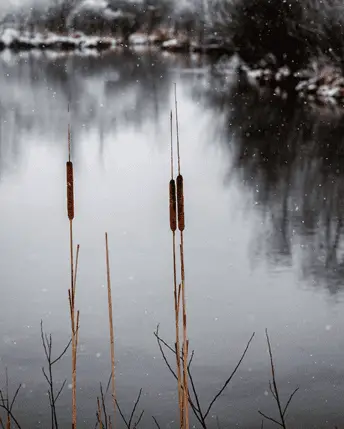
Photo from @mikebricklphotography (IG)
Emergent aquatic plants usually grow in shallow areas. They are often found along the banks of lakes or ponds. Emergent plants are resilient and can thrive on their own, even in varying water depths and availability.
Emergent water plants are often beneficial as a nutrient buffer since they can block or slow down unwarranted nutrients entering the pond. They can also stabilize shorelines and reduce erosion.
Below are some examples and information about common emergent aquatic plants:
- Pickerel Rush: It is easy to find this plant in water garden stores selling aquatic plants. The Pickerel Rush has lovely purple flowers, which is excellent in improving the aesthetic of ponds and aquatic gardens. It will also block some runoff nutrients from entering the pond as well as absorb excess nutrients from the pond water.
- Arrowhead: Arrowhead plants are also known as broadleaf arrowhead, lance-leaved arrowhead, or duck potato. This shallow aquatic weed has leaves that are notably shaped like an arrow. The leaves are mostly found above the water, but sometimes they may also be submerged or floating. It is an excellent aquatic plant to filter nutrients, but you need to monitor the plant to prevent overpopulation.
- Bog Moss: This water plant commonly frequents wetlands or ponds in the form of creeping mats. It is a small, dark, and branched plant with spiral leaves on its stem. Its small flowers usually have three petals. Like other emergent water plants, it can also block runoff nutrients from entering a body of water.
- Cattails: Also known as Tullies, Cattails are the most easily recognizable plant in and around bodies of water. Their spikey, sausage-shaped flowers called catkins appear atop their long, slender stems in late summer to early fall. This plant can be partially submerged and can be a vigorous grower with or without permanent standing water. They can grow up to 5 feet tall. Cattails also serve as cover for wildlife and a food source for aquatic rodents like Muskrats.
- Water Primrose: Also called Pennywort, navelwort; many-flowered Pennywort, this plant has leaves that are round in shape and one inch in diameter. Its leaves are dark green colored and glossy, with scalloped edges. Erect stems happen during the plant’s flowering stage. They commonly bloom between April and September, depends on their species and location. In general, water primroses are considered highly desirable aquatic plants.
- Maidencane: This is one of the many perennial grasses, and although they are familiar to sight, they can be somewhat hard to tell apart. Maidencane plants can measure up to 8 feet in height, with long, narrowly tapered leaves up to 12 inches long and 1 inch wide. This plant often forms dense colonies.
- Purple Loosestrife: Commonly known as Lythrum, salicaire, or rainbow weed– the Purple Loosestrife is a herbaceous perennial plant. It measures up to 3 to 6 feet tall or more in width, given numerous erect stems from a woody root mass. Its stems take on a red-purple color and square shape. This plant can be quite invasive in or out of the water.
- Spike Rush: The term spike rush can refer to any number of different types of spike shaped rushes with a terminal spike that grow in moist soil, marshes, shallow ponds, and wetlands. This plant can span many acres, serving as a cover for other wildlife. Some birds and animals also utilize certain species of Spike Rush as a food source.
- Water Chestnut: This plant is commonly referred to as bull nut, water nut, or Trappa Natans. The Water chestnut is a rooted aquatic plant with a floating leafy rosette on the surface. Its stems can reach up to 16 feet tall, supporting two leaves. The submerged leaves are feathery and whorled along the stem.
The above listed plants are only a small sample of the many different emergent plants that can be used to beautify and clean out waters. Grouping varieties and using varying heights and textures can really give your pond or water garden a unique and beautiful look.
Be aware that many emergent plants grow quite vigorously and many are considered to be invasive or nuisance species.
Submerged Aquatic Plants
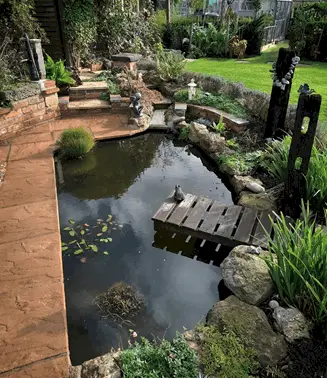
Photo from @cou_ntrylivingcreations (IG)
Submerged aquatic plants are entirely under the water, with a root system in the bottom sediment. However, minor sections may stick above the surface. These plants require water to support their structure physically.
Not all submerged aquatic plants are desirable. To weed out the undesirable varieties, it’s best to consider your personal preference, ecosystem balance, and the overall visual impact.
Some of the most common submerged water plants are listed below:
- Common Waterweed: This branching plant has a long, slender stem with thick leaflets arranged in four whorls. The leaves are finely serrated and might be elliptical or linear in shape. It blooms with white flowers and yellow anthers. Like many other aquatic weeds, this plant needs to be kept under control to avoid taking over your water garden or pond.
- Muskgrass: A form of erect algae, this is an excellent plant for ponds with excessive nutrients as it provides food and shade for fishes. While it may appear like several other aquatic plants, one defining feature would be in breaking its thin straw-like stem. Given this plant is a single-celled stem, the entire stem will turn flaccid once you break it. In comparison, other plants will simply either bend or break.
- Pondweed: This thin-leaved aquatic plant is native to many areas. It has many benefits, such as being a food source, improving oxygen production, and it can be a refuge for other organisms in your pond or water garden. As a native plant, it is not as invasive as others, but it must still be kept in moderation. Some also confuse pondweed for a floating plant due to its surface leaves.
- Bladderwort: This aquatic plant can thrive in ponds and environments with limited nutrients. Do note that this is actually a carnivorous plant. While it can initially look like an unorganized mess, the plants eventually form the starfish shape together. They will then shoot up yellow flowers. The Bladderwort can be a problem if it entirely takes over your pond. Given that this plant is not dependent on nutrients, it can spread rather quickly if left unattended.
- Coontail: A submersed aquatic plant, the Coontail lacks any root structure. Its feathery and fan-shaped leaves are arranged in whorls that resemble the tail of a raccoon. This plant can grow up to 15 inches in height. It may also be found in deep water areas. If you’re planning to control the spread of your coontail, keep in mind that the process can be difficult as it is free-floating.
- Tape-grass or Wild Celery: The moniker “wild celery” makes this plant sound like a regular celery you typically eat in a salad, but the tape-grass or wild celery only grows under the water. Like other aquatic plants, it also offers many benefits to other underwater species. Unfortunately, growing wild celery in your garden will not be possible. Its leaves appear like long ribbons and can measure up to 6 feet long. It’s also commonly referred to as freshwater eel grass.
- Slender Water-nymph: This aquatic plant is typically found in clear, soft water lakes and ponds, most often in shallow waters. Notably, it has flexible, thread-like leaves, sheaths that are more or less rectangular, and 1 to 3 flowers in leaf axils. Its flowers are usually single in the axils along the branches and stem.
- Pipewort: Pipewort is commonly found in shoreline water out to 3-foot depth. Take note that its minuscule size can make it challenging to pick out from among other sedges. Some native species are considered rare or endangered, but this aquatic plant is common within small ranges. Its leaves are linear or sword-shaped, and 2 to 3 flowers make up the flower head in silver, gray, or green colors.
- Lake Quillwort: These herbaceous, spore-bearing plants have grassy spike-like leaves. Their rosette leaves have swollen bases, and sporangia with microspores and megaspores are found within the leaf bases. Most lake quillworts grow submerged as a rosette of linear leaves in freshwater all year. It is commonly found in soft water ponds, lakes, and slow-moving streams and rivers, in less than 2 feet of water. This plant is completely submerged, but it may be immersed near shorelines or stranded on land when water levels drop.
Some species of submerged aquatic plants are primarily used as ornamentals in outdoor water gardens and aquariums. Aside from aesthetic purposes, these water plants are also utilized as essential ecosystem components.
Floating Leaved Aquatic Plants
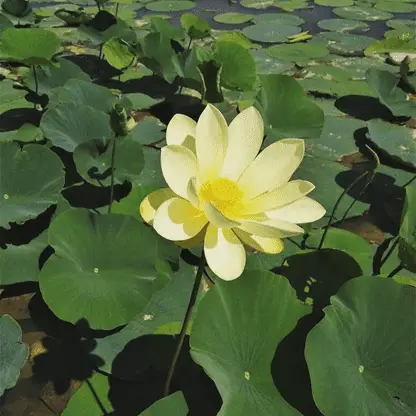
Photo from @itssarah_wilson (IG)
As the name suggests, floating leaf plants refer to rooted plants with most of their leaves drifting on the surface. A number of these plants have some rigidity; hence they may extend a little above the waterline. They are often rooted in the lake bottom and typically grow in protected areas with little wave action.
Here are some common examples of floating leaved aquatic plants:
- Watershield: This aquatic plant is a small, football-shaped leaf that lies flat in surface water, such as ponds. Its size is 2-4 inches and has a dark red color underneath with a gelatinous covering. This native aquatic plant can kill off bacteria and algae and is also used as a hiding place for fish, making it one of the perfect habitats for some ponds.
- American Lotus: The leaves of an American Lotus are almost perfectly round with no cleft. It may look completely flat on the water surface but may raise to 3 feet on a stalk. One of its defining factors is that it often has a yellow flower but may sometimes come in white or pink varieties. This aquatic plant also comes with an extensive root system called rhizomes.
- Spatterdock: This aquatic plant is also known as “cow lily” and has a large heart or oval-shaped leaves. The floating leaves of the spatterdock are connected to a large stem attached to a spongy rhizome. It can grow to 1 foot long and 10 inches wide. Spatterdock also has a very noticeable half-opened yellow flower on the water surface. This flower is attached to a thick round stem which is about 6 feet long.
- Fragrant Water Lily: The fragrant water lily is famous for its round-shaped leaves with a cleft extending to the center. Its size can range from 10 to 30 centimeters wide, while its color appears to be glossy green on the surface and red underneath. Another defining characteristic of this aquatic plant is its flower that it usually has broad petals and a pistil at the center packed with a bright yellow stamen. Lilies can come in many different colors and flower styles.
- Yellow Floating Heart: This aquatic plant is considered a non-native invasive plant that originated from Europe and Asia. It has circular or heart-shaped leaves that are alternately arranged on the stem but opposite of the flower. The yellow floating heart is famous for its bright yellow flower with five petals at the top of the water surface. It also has a lot of flat-shaped seeds per capsule. It grows fast, shading out other native plants and causing damage to the aquatic environment by decreasing the oxygen level in the water and creating a suitable habitat for mosquitoes.
- Floating Marsh-marigold: Considered a rare aquatic plant, the floating marsh marigold can be found in shallow, slow-moving water such as creeks, streams, sheltered lake margins, swamps, and beaver ponds. This plant usually roots in mud, silt, or clay, before spreading when stems root at the nodes. This distinctive aquatic plant has a resemblance to the larger common marsh marigold, which has yellow flowers. Typically, it has 2 to 6 small white flowers about 1 centimeter across, each with five petals.
- Small White Water-lily: The small white water lily is another rare aquatic plant. It has up to 15 white petals and approximately 30 to 45 yellow stamens surrounding a saucer-shaped center disk. Its flowers are single-floating on the water’s surface, only closing up at night while opening up a few hours in a day. Expect to see this floating leaved aquatic plant in shallow, protected bays in lakes and slow-moving streams. They are also common in streams impounded by beaver dams.
- Swamp Smartweed: Aquatic swamp smartweed has oblong leaves that are often flat with a blunt tip. They also have shorter, fatter flower clusters compared to their terrestrial form. Although there are several other smartweeds with pink-colored flower spikes, the Swamp Smartweed has the most shocking pink flowers of the lot. It makes them one of the most easily recognizable water flowers.
Some floating water plants will generally provide enough shade for underwater plants to survive beneath. These plants may serve as excellent fish and wildlife habitats. Take note that a healthy floating-leaved aquatic plant environment may dampen the waves, buffering the shore from the erosive effects of harsh weather conditions like storms and strong winds. Not only that, but they certainly enhance the aesthetic appeal of our ponds and lakes.
Free Floating Aquatic Plants
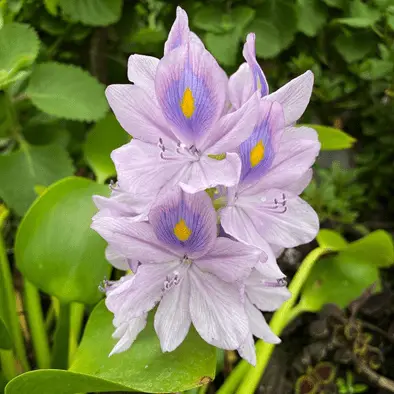
Photo from @huichinhsu (IG)
True to their name, free-floating aquatic plants float freely on the water surface. Like many other water plants, they don’t grow their roots in the soil. Instead, the roots hang down into the water– making the rest of the plant buoyant like a raft. As they are suspended on the water, the plant can be moved around the water garden or pond surface by external factors like wind and strong water currents. These floating plants serve as decor to your backyard water property, plus they are also low-maintenance. Many of these plants only need to be thinned once a year to prevent overtaking the entire water system.
- Mosquito Fern: The mosquito fern is often mistaken as duckweed. Mosquito fern is a free-floating aquatic plant with small leaves arranged opposite the stem. It consists of 2 lobes, the upper lobe floating above the surface and the lower lobe submerged under the water. Its name comes from its ability to fend off mosquitoes from laying eggs in the water. They usually grow on still or slow-moving water such as swamps, ponds, and lakes. Too many colonies of this plant may also decrease the oxygen level in the water for other organisms. Thus, it needs to be controlled before it covers the entire pond.
- Water Hyacinth: Considered as another invasive free-floating plant, the water hyacinth grows in almost all freshwater environments. Its leaves are broadly round or elliptic and usually measure 15 centimeters with glossy green color. Its striking lavender-blue flower with yellow blotch consists of 6 petals, six stamens and measures around 5 centimeters. The fruit of the water hyacinth is a 3-celled capsule containing at least 50 seeds each. When not controlled, this plant may cause a variety of negative impacts in the freshwater. The dense, impenetrable mats that it can form cause waterways to clog, making water activities such as fishing and boating impossible. It can also blocks the air-water interface which can degrade the water quality.
- Duckweed: Commonly found in still-moving ponds, lakes, and sloughs, the duckweed is an individual aquatic plant with an oval-shaped leaf only ¼ inch long. This aquatic plant grows fast and abundantly, making it an excellent food source for waterfowl and fish. However, the dense population of duckweed can be a nuisance for humans because they block the waterways. Recently, science and agriculture have made creative uses for the abundant amount of duckweed. They are usually harvested to eliminate pollutants and serve as feed to livestock and fertilizer for other crops. Meanwhile, researchers have tried to synthesize insulin by utilizing genetically modified duckweed.
- Watermeal: Considered the smallest seed-bearing plant, the watermeal is a tiny elliptical-shaped aquatic plant measuring only 1 millimeter. Individually, it is hard to see them with the naked eye, but easier to see as it colonizes because they form large, green masses on the water surface. Commonly found in stagnant or still-moving water, this rootless plant is usually seen growing with duckweeds and mosquito ferns. Their fast-growing population can deplete the oxygen in the water quickly and may cause fishes and other respiring organisms to die.
- Floating Crystalwort: This aquatic plant is a very popular aquarium plant in the US. It is commonly found in slow-moving ponds and streams. The submerged portion of the floating crystalwort serves as a suitable habitat for small invertebrates and becomes food for other amphibians and reptiles. The unique characteristic of the floating crystalwort is that its stem and leaves are almost identical. It is considered thick for its size and measures 0.08 inches wide. Despite the lack of function of its thin and colorless roots, they still help the floating crystalwort anchor in the mud.
- Florida Mudmidget: Floating just beneath the water surface, this aquatic plant grows in rivers, lakes, ponds, and sloughs. This Florida native plant is considered another small duckweed. It has narrow, elongated fronds that connect to form colonies. The size of the fronds is only about 5 to 10 millimeters, with a tiny flower that is hard to see.
- Giant Salvinia: This floating aquatic fern thrives in slow-moving, nutrient-rich freshwaters. It spreads aggressively and produces a floating canopy on the surface of lakes, rivers, and ponds. Through water currents, it is dispersed long distances within a waterbody or between water bodies with the help of animals and equipment like boats or vehicles. In some cases, the Giant Salvinia is cultivated by aquarium and pond owners and released through flooding or intentional dumping.
- American Featherfoil: The American featherfoil is usually found in shallow, clear organic waters. It is an aquatic herb that has erect hollow and leafless flower stems. Each one grows a series of large, spongy, and air-filled flowering stalks. The air helps the plant stems buoy up above the water surface. However, it does not float much, given that its stem and roots anchor it firmly into place. It’s challenging to spot this plant in the water. To find it, look in shallow waters of ditches, ponds, and swamps without too much disturbance.
- Water Cabbage: Also known as water lettuce, Nile cabbage, or shellflower, this free-floating plant has thick, soft leaves that resemble a rosette. It drifts on the water surface, with the roots hanging submersed beneath floating leaves. Notably, the water cabbage is one of the most productive freshwater water plants in the world. Its leaves can measure up to 14 centimeters long without a stem. They are also often utilized in tropical aquariums to serve as cover for fry and small fishes.
If you’re planning to include free-floating water plants into your large pond or an enclosed body of water– the greenery can easily make your man-made feature look more natural. However, some may be invasive, which can be harmful to the ecosystem in the long run. It’s your responsibility to keep all your aquatic plant species in check to strike a balance.
Frequently Asked Questions
What helps aquatic plants to float in water?
There is a particular tissue called Aerenchyma, which allows aquatic plants to float. The parenchyma cells form a network with air cavities that perform a gaseous exchange, making the plant light and buoyant, therefore allowing them to float in water.
Do aquatic plants have cuticles?
Most aquatic plants do not have nor need cuticles. The primary function of cuticles is to prevent water loss from plants. Since aquatic plants live directly in a well-watered environment, they do not need cuticles in any of their parts.
Do aquatic plants oxygenate water?
Yes, aquatic plants oxygenate the water and consume CO2 during the day, which helps the fishes and stabilize the pH level in the water.
What pond plants keep water clear?
Oxygenating pond plants such as Hornwort and Water Thyme are effective clear water plants feeding through their foliage and roots. Floating pond plants like water hyacinth and water lettuce are also good water filter plants because they feed heavily and grow fast. These plants also provide shade in the pond through their size by blocking the sunlight, which helps fight algae growth.
Can you have too many oxygenating aquatic plants in a pond?
Having too many oxygenating aquatic plants in a pond may cause the oxygen and pH levels to fluctuate. Aquatic plants consume oxygen at night, leaving little to no oxygen for other respiring organisms in the pond. For people with fish in their pond, not only does it lessen the oxygen in the water, but too many submerged oxygenated aquatic plants may also leave no room for your fish to swim around.
Final Thoughts
Aquatic plants are one of the best additions to your water garden or pond. Free-floating flowers and lush greenery could undoubtedly accent your fountains and grow right inside the basin.
Not only do they add aesthetic value, but they also help maintain your pond’s ecosystem and provide many benefits to your fish– though you will still need to manage their growth to prevent invasive species from overtaking the waters.
The aquatic plants included in this article are perfect even for a beginner, so here’s to hoping you’ll take what you’ve learned and put it to good use!

